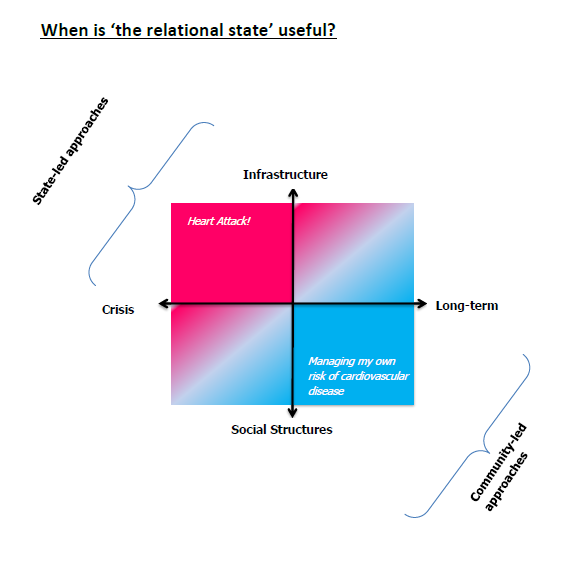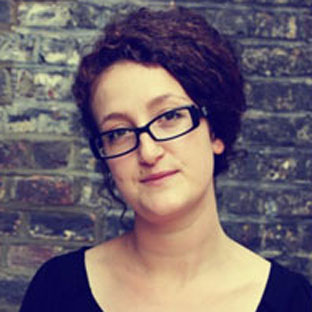What is the relational state if you look it in the eye? I am outlining Five rules, Four Principles, Three approaches, Two caveats and One request to using community-led or relational state approaches. These blogposts have emerged around a couple of presentations I have given recently, and I hope they will be of interest and use to anyone who does voluntary or community work, or who works for or with private, public or third sector organisations that work with people and/or communities at a local level.
This [..] is intended as a work-in-process idea that I am very happy for people to take apart
Three approaches:
Yesterday I outlined the idea of a scale that runs from long-term condition to one-off crisis, intersected by one that runs from infrastructure to social structure. This is sketched out in the image below, and is intended as a work-in-process idea that I am very happy for people to take apart!
The thinking is that the closer you are to longer-term conditions and social structures, the more community-led and co-produced approaches are appropriate; the closer you are to crisis and infrastructure, the more state or centre-led approaches are appropriate. If you are having a heart attack you will need a non-co-produced state-led intervention to save you; to ensure you live beyond fifty, community-based services and a co-produced approach to managing your lifestyle will be most appropriate.

For projects and initiatives that address and are linked to social structures and social norms; or that are linked to managing long-term, chronic or lifestyle-related issues, we have found the following three approached to be useful. This covers anything from the community management of assets such as libraries, to key approaches that could be useful for a care worker who is working with a client to ‘knit’ them back into their local community.
Three approaches: capacity building, network weaving and brokering.
1. Capacity Building: it is not enough to ‘hand over’ power or control; local people and institutions need the knowhow, abilities and support mechanisms in place to keep local projects running: this can be anything from wellbeing to fundraising training.
A capacity building approach seeks to understand what blocks people and organisations in the public, private and voluntary sectors from realising their economic and social aspirations, whilst enhancing the abilities and skills that will allow them to succeed.
A healthy heart?
A capacity building approach to cardiovascular health might involve:
-
Training local practitioners on how to co-produce healthy eating or healthy living plans with their clients;
-
Training local people to act as ‘community champions’ or ‘health champions’, linking people at risk of heart disease to exercise programmes such as walking groups, or food initiatives such as allotments or ‘bake your own bread’ clubs;
-
Working directly with people at risk of poor heart health, maybe giving them wellbeing training, offering community cooking courses or health advocacy courses.
2. Brokering: often people and places contain everything that is needed; they just need to be joined up better. In our work in deprived areas around England, we often found a split between local people who do not feel anything good happens in their areas, and local activists and service providers who work incredibly hard to provide little-used local groups, activities and amenities. Brokering approaches are about signposting and linking to existing resources.
A healthy heart?
A brokering approach to cardiovascular health might involve:
-
Offering exercise on prescription, or social prescriptions more generally;
-
Training local practitioners in approaches such as social prescribing;
-
Promoting signposting to local groups.
3. Network Weaving- sometimes brokering is not enough: in social prescribing, for example, the big question is not around how you spread information, but how behaviour change happens. Network weaving is an approach where connections are built over time: this can be between people; it can be helping to build better working relationships between existing local group and/or service providers.
A healthy heart?
A network weaving approach to cardiovascular health might involve:
-
Working one-on-one with people to weave them back into their local community: health trainers will have six sessions with an individual to co-produce a plan that links them back into their local area;
-
Hands-on approaches to initiatives such as being a community or health champion, that involve going to local activities with people, until they are comfortable going alone;
-
Working to network local organisations together, such that they can offer a better and more integrated response in areas with high risk of lifestyle-related cardiovascular disease.
In practice: social inclusion for mental wellbeing
Very few projects will use just one approach: the projects that we have trialled as part of the seven-site social inclusion for mental wellbeing have tended two building on our findings, community rules and principles by using a blend of the above approaches. Talk for Health is a way of building local capacity by training people in lay mental health counselling. It ensures sustainability through encouraging (or ‘network weaving’) densely-knit support networks between project participants.
The Murton Mams project emerged due to local data that showed that local single parents were at risk of low wellbeing and that having community and social connections helped them do better. It started as a nomadic social group, moving from community centre to community centre, as our data showed that different local resources had different cliques around them. What started as network weaving – linking single parents to each other and giving them a taste of the different resources available in their area – quickly became capacity building: the mams have now secured their own funding, which will allow them to take the group in the directions that they chose.
If you found this interesting, follow me and stay tuned for Two caveats and One request!
Part 1: Five community rules, can be found here
Part 2: Four principles, can be found here
Gaia Marcus is former Senior Researcher on the RSA Connected Communities project.
She is an Edgeryder and an UnMonk advisor, founded the RSA Social Mirror project and is ¼ of the ThoughtMenu.
This Summer she will be cycling 1000km in memory of our RSA colleague Dr Emma Lindley and in aid of Mind
You can find her on twitter: @la_gaia



Be the first to write a comment
Please login to post a comment or reply.
Don't have an account? Click here to register.